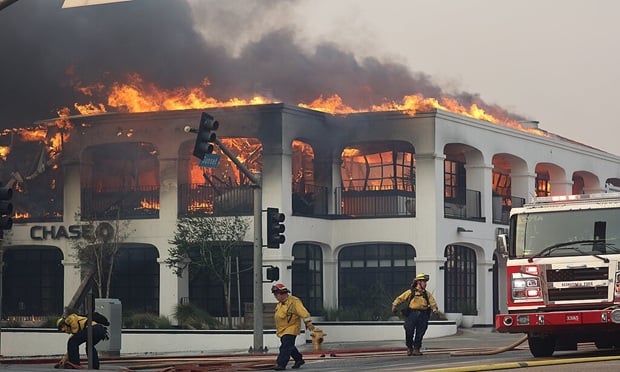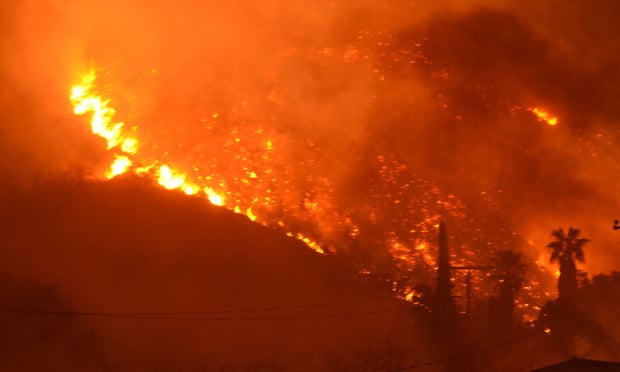The sky is falling, or so it would have seemed in 2011, a year marred by record-setting devastation that scarred both the earth and the human spirit. During those tempest-tossed days, Mother Nature angrily lashed out with howling storms, raging waves that engulfed cities and villages, and pernicious fires that devoured timber and swaths of homes. When the smoke had cleared, millions were left with the sound, the fury, and the pain. But that was just the beginning for the claims industry, which swiftly rose to restore order from the chaos of numerous billion-dollar calamities.
To say nothing of the thousands of lives lost, here are some statistics that emerged from last year's meteorological chaos to put it all in perspective:
- The deadliest earthquake season since 2008.
- The most destructive wildfire season in Texas history spawned more than 29,000 fires, burning through 3.9 million acres and half a million properties.
- More disaster zones declared by U.S. federal authorities than any other year in history.
At Home and Abroad During the first half of 2011, we witnessed a virtually unprecedented number of severe natural catastrophes, with hundreds of events causing multi-billion-dollar damage. Unfortunately, Mother Nature was just getting started. Both Zurich and Swiss Re have estimated catastrophe-related economic losses in 2011 to be around $350 billion—the highest in recent memory. Had Japan been more fully insured for earthquakes, 2011 would have set a record for insured catastrophe losses. As it stands, the $108 billion in insured man-made and natural catastrophe losses this past year places second to the $123 billion in 2005.
The tragic earthquake in Japan on March 11 and the ensuing tsunami caused insured losses of $35 billion, while the Feb. 22 temblor in New Zealand inflicted a total of $12 billion in damage. At press time, experts estimated that the floods in Thailand caused between $8 billion and $11 billion in damage. Severe storms in the U.S. in April and May cost about $14 billion, with Hurricane Irene battering the Northeast—and its many homeowners who lack flood insurance. The tally for Irene's wrath now stands at $4.9 billion.
Selective Amnesia? There are too many figures to dilute to the confines of these pages, and too many horrific scenes to relay. Suffice it to say, the 2011 catastrophe season catalyzed P&C insurers, government agencies, risk managers, and economists—all of whom are rethinking their preparedness modus operandi and devising progressive strategies for a new year certain to be fraught with uncertainties. While it would be naïve to propose a “silver lining,” there are valuable lessons to be learned, in regard to overall claims handling, catastrophe response, and speeding policyholder indemnity. In addition, what some meteorologists have diagnosed as a “state of amnesia” here in the U.S. has perhaps been remedied by tornadoes and tropical storms striking in unexpected geography.
 One case in point was Hurricane Irene, which reminded us that, yes, land falling hurricanes do happen on U.S. soil, even in a metropolis such as New York City. Irene commanded many a googly-eyed newspaper headline during the Atlantic hurricane season that officially concluded on Nov. 30. Its imprint included 20 named tropical storms and seven hurricanes, three of which were major hurricanes.
One case in point was Hurricane Irene, which reminded us that, yes, land falling hurricanes do happen on U.S. soil, even in a metropolis such as New York City. Irene commanded many a googly-eyed newspaper headline during the Atlantic hurricane season that officially concluded on Nov. 30. Its imprint included 20 named tropical storms and seven hurricanes, three of which were major hurricanes.
“When compared to the historical average, this year's Atlantic hurricane season forecast offered an ominous outlook for 2011, and it certainly delivered,” noted Peter Dailey, Ph.D., director of atmospheric science at AIR Worldwide.
“What made the disruption caused by Irene so notable was that it struck cities and towns along the Northeast corridor of the U.S.—an area largely unaffected by hurricanes since Floyd made its impact along a strikingly similar track in 1999,” Dailey added.
I spoke with Jeffrey Bowman, CEO of Crawford & Company, about responding to Irene and a slew of other global catastrophes, hoping to gain knowledge to assist P&C insurers of virtually any size, and obviously claims departments and the brave souls who keep them running. I was not disappointed. Below are some excerpts from our recent conversation:
Bramlet: Is Crawford still sifting through claims related to Irene? BOWMAN: Well, we have already closed nearly 95 percent of the claims from that fall storm. In years gone by, a hurricane happening in September would trickle over into the new year. Today, however, we can process claims much more efficiently. I think success here hinges on being much more responsive while ensuring the surrounding communications are optimal.
Bramlet: What can this momentous year teach claims operations about catastrophe response?
BOWMAN: From an international perspective, Crawford has been able to respond to catastrophes successfully by deploying specialized teams that can get inducted quickly and can hit the ground running, so to speak, solving problems at the damage site soon after arrival. With operations in 70 countries in the world, we have the infrastructure and back-office support in place to enable a smooth claims handling process.

Aside from the catastrophes on our home shores, Crawford has also been working in Australia, New Zealand, Japan, and in Thailand. In claims handling, we have learned that, in some respects, it doesn't matter if it is a momentous season or [merely] an average one. Weather events happen every year and require an organization to be prepared around the year regardless.
Bramlet: So you are saying that catastrophe planning really is a year-round endeavor? BOWMAN: Absolutely. Part of that preparation involves managing various moving parts and precisely executing technology and utilizing skilled claims personnel.
Bowman stressed that mobilizing individuals entails coordination of appropriate licenses, certifications and language skills, as well as allocating resources strategically.
Bramlet: A term that keeps cropping up is 'strategic loss management.' What does that mean exactly, and how does that play out when adjusters are deployed to disaster areas? BOWMAN: True strategic loss management encompasses assembling a qualified team to handle major losses. One must take into account how to plan with the insured; how to rebuild. The entire process is refined to mitigate expenses and help get insureds back to normal as quickly as possible. There are considerations such as cash flow management, effectively communicating with all players, including contractors, engineers, and reinsurers. Our teams must be able to deal with problems as they arise in real-time and in a very specific way to ensure there are absolutely no missteps. There is no room for error or delays.
Available and Responsive Precise project management in claims also requires fastidious logistics planning and pooling of available resources well in advance of disaster striking, as Bowman explained.
 BOWMAN: Take Thailand at the moment, for example. We have a multi-national team of U.K. , U.S., and Australian adjusters who are working on significant business interruption and property damage claims. In the U.S., we have a specific catastrophe management team that supports both our U.S. branch offices and can also be deployed overseas. We do this year in and out whether there are significant events or few events, and we've had a mixture of both in the last few years. The U.S. is very specific in having those weather patterns and volatility.
BOWMAN: Take Thailand at the moment, for example. We have a multi-national team of U.K. , U.S., and Australian adjusters who are working on significant business interruption and property damage claims. In the U.S., we have a specific catastrophe management team that supports both our U.S. branch offices and can also be deployed overseas. We do this year in and out whether there are significant events or few events, and we've had a mixture of both in the last few years. The U.S. is very specific in having those weather patterns and volatility.
Meeting and exceeding client expectation and assessing damages correctly in precarious situations requires thoughtful consideration of all logistics. Internationally, you just can't put someone in an airplane and send them to a country to work. Be sure to get the right papers in place for work permits to enable individuals to be correctly licensed or supported. And obviously the appropriate language skills or a translator is essential for non-English speaking countries.
Bowman emphasized these considerations when insurers devise their own teams of claims professionals to deploy abroad:
- Expertise. Match the skill set of the claims adjuster to the specific catastrophe event.
- Culture. Especially imperative when deploying adjusters to the countries but nevertheless applies in the U.S.
Bramlet: Would you elaborate more on acclimating adjusters to unfamiliar locales and cultures? BOWMAN: Certainly. The biggest issue of transferring staff around is the culture component. A claims organization must think about how it will prepare its staff to enter another environment.
Now consider entering a damage site. Adjusters must be ready to act and deal with the problems clients have immediately. There is a marked difference between international and local, indigenous companies, so one must be very careful.
Legacy of Learning Bramlet: What else can domestic enterprises learn from Crawford's successes about keeping operations, and by extension, claims running along smoothly? BOWMAN: As a company, we have 8,900 employees on a global basis. To respond to catastrophes on U.S. soil, we have a division with about 1,800 claims adjusters on standby. We can ensure that we have the most desirable candidates, who are licensed in areas where they need to be deployed. They must also be trained in our technology.
Because our technology system is fairly sophisticated, we conduct training courses throughout the year and event-specific induction courses pri or to deploying the adjusters to the damaged area. The adjuster must be well-versed in the type of business appropriate for each client, which, again, shows the importance of planning ahead.
 It is also imperative to understand each client or policyholder's requirements. Crawford accomplishes this via some in-house tools. We have a command center where we're able (if necessary) to take companies' policy records and map them over the area that has been damaged to very quickly get a definitive idea of how many staff we'll need, potential damages, if we can segment the claims, and break it down to expertise we need as well to dispatch.
It is also imperative to understand each client or policyholder's requirements. Crawford accomplishes this via some in-house tools. We have a command center where we're able (if necessary) to take companies' policy records and map them over the area that has been damaged to very quickly get a definitive idea of how many staff we'll need, potential damages, if we can segment the claims, and break it down to expertise we need as well to dispatch.
Work, Life and Adventure Again, this high level of data procurement and management is clearly not a “fly-by-the-seat-of-the-pants” type of arrangement. Rather, Bowman stressed that this must be orchestrated and then executed very quickly to maximize cost savings for both the client and the insurer. While Bowman said that responding to the slew of widespread disasters yielded very few snafus, he did relay an amusing anecdote that speaks to certain key attributes of a typical claims adjuster, namely: tenacity, dedication, and the ability to practice humor in even the most difficult situations.
Bramlet: Have any staffers relayed amusing stories to you about working in the trenches? BOWMAN: One of our managers in Thailand e-mailed me to talk about this problem he was having in Bangkok. He then told me, 'I have crocodile in my back garden, which I have to navigate way around each day. Staff members are arriving to the office via canoes, and not one has had the day off yet.'
The flooding of nearly biblical proportions has allowed snakes and crocodiles to basically get into places they shouldn't be. So we joked that at our Atlanta headquarters we would not complain about snow.
Bramlet: All joking aside, you acknowledge the tremendous sacrifice of claims adjusters, especially those who are deployed to unfamiliar areas in times of extreme stress, and for months on end. Tell us more. BOWMAN: It takes a certain type of character to work in claims. It takes a certain type of person to volunteer for deployment. While we do not force anyone to go, many adjusters actually want overseas deployments.
Bramlet: So who are these eager volunteers? BOWMAN: A large number of them are Millennials. The younger members of Crawford's adjusting fraternity are often excited to work on our company's overseas operations.
This openness and propensity can be attributed to wanderlust in many cases. Adventure aside, these “volunteers” are seeking challenges and ways to meaningfully interact with—and assist—policyholders in distress. This leads me to believe that perhaps there is hope for talent recruitment in the industry after all.
Want to continue reading?
Become a Free PropertyCasualty360 Digital Reader
Your access to unlimited PropertyCasualty360 content isn’t changing.
Once you are an ALM digital member, you’ll receive:
- Breaking insurance news and analysis, on-site and via our newsletters and custom alerts
- Weekly Insurance Speak podcast featuring exclusive interviews with industry leaders
- Educational webcasts, white papers, and ebooks from industry thought leaders
- Critical converage of the employee benefits and financial advisory markets on our other ALM sites, BenefitsPRO and ThinkAdvisor
Already have an account? Sign In Now
© 2025 ALM Global, LLC, All Rights Reserved. Request academic re-use from www.copyright.com. All other uses, submit a request to [email protected]. For more information visit Asset & Logo Licensing.








